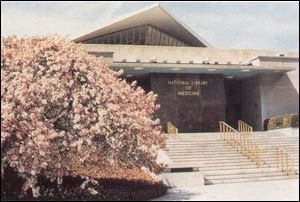NIH's Centers
Research in medicine knows no international boundaries. Since its founding, the NIH has maintained close relations with many of its Western Hemisphere counterparts through the Pan American Sanitary Bureau, now called the Pan American Health Organization . In 1947, the first NIH grants were awarded to investigators in foreign universities, and in 1968, the creation of the John E. Fogarty International Center institutionalized coordination of international exchanges at NIH. The Fogarty Center also maintains liaisons with the World Health Organization and European medical research organizations. One branch of the center supports translation, documentation, and critical reviews of new health science information.
Worldwide biomedical communications are also fostered by the NIH's National Library of Medicine (NLM) . As the world's largest medical library, the NLM boasts a collection of more than 5.1 million items. Founded in 1836 as the library of the surgeon general of the Army, the NLM became a component of NIH in 1968. The NLM has made freely available on the World Wide Web a database holding the most current medical literature. Also available are LocatorPlus, the online catalog of books and manuscripts in the library, AIDSLINE, a subset of MEDLINE devoted to AIDS research, and various databases useful for researchers, practicing physicians, and members of the public who use the resources available for research on medical topics.
During World War I, the Public Health Service attended primarily to sanitation of areas around military bases in the U.S. The staff of the Hygienic Laboratory traced the cause of anthrax outbreaks among the troops to contaminated shaving brushes and discovered that the bunion pads widely used to cover smallpox vaccinations could harbor tetanus spores. In 1916, the director of the laboratory, Dr. George McCoy , hired the laboratory's first female bacteriologist, Dr. Ida Bengtson. When the 1918 influenza pandemic struck Washington, physicians from the laboratory were pressed into service treating patients in the District of Columbia because so many local doctors fell ill.
In 1930, the Ransdell Act changed the name of the Hygienic Laboratory to National Institute (singular) of Health (NIH) and authorized the establishment of fellowships for research into basic biological and medical problems. The roots of this act extended to 1918, when chemists who had worked with the Chemical Warfare Service in World War I sought to establish an institute in the private sector to apply fundamental knowledge in chemistry to problems of medicine. In 1926, after no philanthropic patron could be found to endow such an institute, the proponents joined with Louisiana Senator Joseph E. Ransdell to seek federal sponsorship. The truncated form in which the bill was finally enacted in 1930 reflected the harsh economic realities imposed by the Great Depression. Nonetheless, this legislation marked a change in the attitude of the U.S. scientific community toward public funding of medical research.
National Library of Medicine


